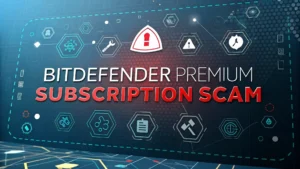Amazon Prime scam emails are becoming more sophisticated each year. These fake messages target millions of users worldwide, trying to steal personal information and money.
Scammers use clever tactics to make their emails look real. They copy Amazon’s design and language perfectly. Many people fall for these tricks because the emails seem genuine.
This guide will teach you everything you need to know about Amazon Prime scam emails. You will learn how to identify fake messages instantly. We will show you what actions to take if you receive one. Most importantly, you will discover how to protect yourself from future attacks.
Key Takeaways
- • Amazon never asks for sensitive information via email – Real Amazon emails will never request passwords, credit card numbers, or Social Security numbers through email links
- • Check the sender’s email address carefully – Legitimate Amazon emails always come from @amazon.com domains, not suspicious addresses like @amazon-security.net or @prime-amazon.org
- • Look for urgent language and pressure tactics – Scam emails often use phrases like “immediate action required” or “account will be suspended” to create false urgency
- • Verify through official channels – Always log into your Amazon account directly through the official website or app rather than clicking email links
- • Report suspicious emails immediately – Forward phishing emails to stop-spoofing@amazon.com and delete them from your inbox to prevent accidental clicks
What Are Amazon Prime Scam Emails
Amazon Prime scam emails are fraudulent messages that pretend to come from Amazon. These emails try to trick you into giving away personal information. Scammers create fake emails that look exactly like real Amazon communications. They use Amazon’s logo, colors, and official language.
These phishing attacks target your Amazon account credentials. Criminals want your username, password, and payment information. They might also try to steal your personal details like your address or phone number. Some scams even attempt to install malware on your device.
The emails often claim there is a problem with your Prime membership. They might say your payment method failed or your account needs verification. Other common themes include suspicious account activity or security alerts. All of these are designed to make you panic and act quickly.
Modern scam emails are extremely sophisticated. They include realistic Amazon formatting and proper grammar. Some even use your real name and partial account information. This makes them much harder to detect than older, obvious fake emails.
Common Types of Amazon Prime Scam Emails
Several different types of Amazon Prime scam emails circulate regularly. Understanding these categories helps you recognize threats faster. Each type uses different psychological tricks to fool victims.
Account suspension emails are very common. These messages claim your Prime account will be suspended soon. They usually mention suspicious activity or policy violations. The goal is to make you panic and click their malicious links.
Payment failure notifications represent another major category. These emails claim your credit card was declined or expired. They ask you to update your payment information immediately. Real Amazon emails about payment issues look different and have specific characteristics.
Prize and gift card scams promise free rewards. These emails claim you won a contest or received a gift card. They ask you to claim your prize by clicking a link. This type of scam targets people who want something for free.
Security alert emails claim unauthorized access to your account. They might mention login attempts from unusual locations. These emails try to scare you into clicking verification links. Legitimate security alerts from Amazon have different formatting and language.
How to Identify Fake Amazon Prime Emails
Learning to spot fake Amazon emails requires attention to detail. Several clear warning signs can help you identify scams quickly. Always examine emails carefully before taking any action.
Check the sender’s email address first. Real Amazon emails come from specific domains like @amazon.com. Fake emails often use similar but incorrect addresses. Examples include @amazon-security.net or @amazonprime-support.com. These slight differences are major red flags.
Look for spelling and grammar mistakes. Professional companies like Amazon proofread their communications carefully. Scam emails often contain obvious errors. Poor grammar, misspelled words, and awkward phrasing indicate fake messages.
Examine the email formatting closely. Real Amazon emails have consistent branding and layout. Fake emails might have blurry logos or incorrect colors. The spacing and alignment might look unprofessional. Trust your instincts if something looks wrong.
Check for urgent language and pressure tactics. Scam emails often demand immediate action. They use phrases like “act now” or “within 24 hours.” Real Amazon emails rarely create artificial urgency about account issues.
Red Flags That Signal Scam Emails
Certain warning signs appear in almost all Amazon Prime scam emails. Learning these red flags helps you avoid falling for tricks. Always be suspicious when you see these elements.
Requests for sensitive information are major red flags. Amazon never asks for passwords, credit card numbers, or Social Security numbers via email. Any email requesting this information is definitely fake. Legitimate companies have secure ways to collect sensitive data.
Suspicious links and attachments indicate scam emails. Hover over links to see the actual destination. Fake emails often lead to non-Amazon websites. Never download attachments from suspicious emails. These files might contain malware or viruses.
Generic greetings suggest mass-produced scam emails. Real Amazon emails usually address you by name. Fake emails might use “Dear Customer” or “Dear Prime Member.” Personalization is a sign of legitimate communication.
Mismatched information reveals fake emails. The sender name might say “Amazon” but the email address looks suspicious. The content might mention services you don’t use. These inconsistencies expose fraudulent messages.
What Happens If You Fall for a Scam
Falling for an Amazon Prime scam can have serious consequences. Understanding these risks motivates better security practices. Quick action after a mistake can limit damage.
Identity theft is a major concern after scam exposure. Criminals might use your personal information to open new accounts. They could apply for credit cards or loans in your name. Financial fraud can damage your credit score and cost thousands of dollars.
Account takeover happens when scammers get your login credentials. They might change your password and lock you out. Criminals could use your account to make purchases with your saved payment methods. Your entire Amazon history becomes accessible to thieves.
Malware infections occur when you download malicious attachments. These programs can steal additional information from your computer. They might record your keystrokes or access your files. System security becomes compromised, affecting all your online activities.
Financial losses can be immediate and severe. Scammers might make unauthorized purchases quickly. They could drain your bank account or max out credit cards. Recovery time for financial losses varies but can take months or years.
How to Verify Legitimate Amazon Emails
Verifying real Amazon emails protects you from scams. Several methods help confirm authentic communications. Always verify before taking action on any email.
Log into your Amazon account directly through the official website or app. Check your account notifications and messages. Real Amazon emails will have corresponding notifications in your account. This verification method is the most reliable way to confirm authenticity.
Check the email headers for technical details. Real Amazon emails have specific routing information. Look for legitimate Amazon server names and IP addresses. Email headers contain detailed information about the message’s origin and path.
Contact Amazon customer service directly if you’re unsure. Use the phone number or chat feature from the official website. Never use contact information from suspicious emails. Customer service representatives can verify whether Amazon sent specific messages.
Compare with previous legitimate emails from Amazon. Real Amazon emails have consistent formatting and language. Look for similarities in design, tone, and structure. Pattern recognition helps identify authentic communications over time.
Steps to Take When You Receive a Scam Email
Receiving a scam email requires immediate action. Following proper steps protects you and helps others. Never ignore suspicious emails or assume they’re harmless.
Do not click any links in the suspicious email. Avoid downloading attachments or providing any information. Simply opening some malicious attachments can compromise your security. Close the email immediately if you suspect it’s fake.
Forward the email to stop-spoofing@amazon.com. Amazon investigates reported phishing emails and takes action against scammers. Reporting suspicious emails helps protect other users from similar attacks. Include the entire email with headers when reporting.
Delete the email from your inbox after reporting it. Don’t keep fake emails as references or examples. Accidental clicks can still happen if you keep suspicious messages. Empty your deleted items folder to completely remove the threat.
Change your passwords if you suspect your account is compromised. Use strong, unique passwords for all your accounts. Enable two-factor authentication for additional security. Update your security questions and recovery information as needed.
Protecting Your Amazon Account From Future Scams
Account security requires ongoing attention and regular updates. Implementing strong security measures prevents most scam attempts. Proactive protection is much easier than recovering from fraud.
Enable two-factor authentication on your Amazon account. This adds an extra security layer beyond your password. Even if scammers get your password, they can’t access your account without the second factor. Use authenticator apps rather than SMS when possible.
Use strong, unique passwords for your Amazon account. Avoid using the same password for multiple accounts. Password managers can generate and store complex passwords safely. Change your password regularly, especially after security incidents.
Monitor your account activity regularly. Check your order history and account settings frequently. Set up account alerts for purchases and login attempts. Quick detection helps minimize damage from unauthorized access.
Keep your contact information updated in your Amazon account. Accurate phone numbers and email addresses ensure you receive legitimate security notifications. Outdated information can prevent you from receiving important account alerts.
How to Report Amazon Prime Scam Emails
Reporting scam emails helps protect everyone from fraud. Amazon and law enforcement agencies use these reports to track scammers. Your report might prevent others from falling victim to the same scam.
Forward suspicious emails to stop-spoofing@amazon.com immediately. Include the complete email with all headers and attachments. Amazon’s security team investigates each report and takes appropriate action. Don’t edit or modify the email before forwarding.
Report to the Federal Trade Commission through their online complaint system. The FTC tracks fraud trends and prosecutes large-scale scammers. Government agencies need detailed reports to build cases against criminals. Include all relevant information about the scam attempt.
Contact your local police if you suffered financial losses. File a report with your local law enforcement agency. Police reports create official records that help with insurance claims and credit disputes. Some departments have specialized cybercrime units.
Notify your bank and credit card companies about the scam attempt. Even if you didn’t provide financial information, alert them to potential fraud. Financial institutions can monitor your accounts for suspicious activity. They might also flag similar scam attempts targeting other customers.
Alternative Ways Scammers Target Amazon Prime Users
Amazon Prime scams extend beyond email to other communication channels. Scammers use phone calls, text messages, and social media to reach victims. Understanding all attack vectors helps you stay protected across platforms.
Phone call scams involve criminals pretending to be Amazon representatives. They might claim there’s a problem with your account or a suspicious order. Never provide personal information over the phone unless you initiated the call to Amazon directly.
Text message scams use SMS to deliver malicious links. These messages often claim delivery problems or account issues. Legitimate Amazon texts come from specific numbers and have different characteristics than scam messages.
Social media scams use fake Amazon pages and posts. Scammers create convincing social media profiles that look official. They might offer fake contests or customer service through social platforms. Always verify social media accounts before engaging.
Fake websites copy Amazon’s design to steal login credentials. These sites might appear in search results or email links. Always check the URL carefully before entering any information. Legitimate Amazon websites use specific domain names and security certificates.
What to Do If Your Information Was Compromised
Discovering compromised information requires immediate action. Quick response can prevent further damage and unauthorized access. Time is critical when dealing with identity theft and account compromise.
Change all your passwords immediately. Start with your Amazon account, then update all other online accounts. Use completely different passwords for each account. Consider using a password manager to generate strong, unique passwords.
Contact your bank and credit card companies right away. Report the potential fraud and request new cards. Monitor your accounts closely for unauthorized transactions. Set up fraud alerts on all your financial accounts.
Check your credit reports from all three major credit bureaus. Look for new accounts or inquiries you didn’t authorize. Place a fraud alert on your credit file to prevent new accounts from being opened. Consider freezing your credit if necessary.
File a police report if you suffered financial losses. Document all communication with scammers and keep records of financial damage. Official police reports help with insurance claims and credit disputes. Some areas have specialized cybercrime units that handle these cases.
Frequently Asked Questions
How can I tell if an Amazon email is real?
Check the sender’s email address for @amazon.com domains and log into your account directly to verify any claims made in the email.
What should I do if I clicked a link in a scam email?
Change your Amazon password immediately, run antivirus software, and monitor your accounts for unauthorized activity.
Does Amazon ever ask for passwords via email?
No, Amazon never requests passwords, credit card numbers, or sensitive information through email communications.
How do I report a fake Amazon email?
Forward the entire email to stop-spoofing@amazon.com and delete it from your inbox after reporting.
Can scam emails install viruses on my computer?
Yes, malicious attachments and links can install malware that steals information or damages your system.
What happens if I entered my information on a fake website?
Change your passwords immediately, contact your bank, and monitor your accounts for unauthorized activity.
How often should I check my Amazon account for suspicious activity?
Review your account weekly and check immediately after receiving any suspicious emails or notifications.
Are Amazon Prime scams increasing?
Yes, these scams are becoming more sophisticated and frequent, especially during peak shopping seasons.
What information do scammers want from Amazon Prime users?
They target login credentials, payment information, personal details, and account access to commit fraud.
How do I enable two-factor authentication on my Amazon account?
Go to your account settings, select “Login & security,” and follow the prompts to set up two-factor authentication.



























